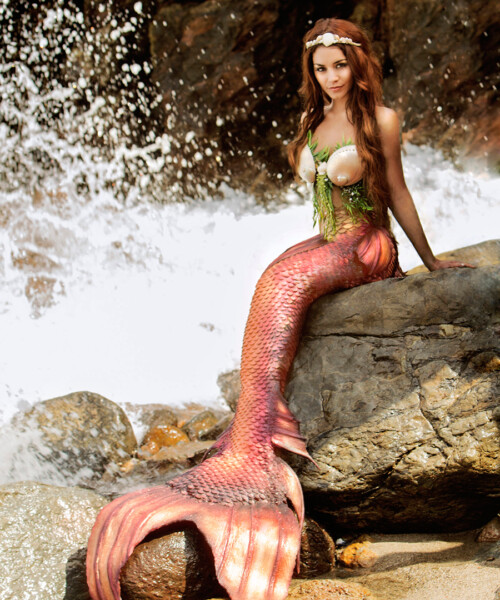Shaye Moon spent more on her tail than she did on her wedding dress—and she doesn’t regret it a bit. “I’m wearing it more,” the 36-year-old says of the silicone contraption, which she straps on to splash around in a swimming pool near her Florida home. And she isn’t the only one. Look around your local pool or search Instagram for #mermaid and you’re likely to see something a bit, well, fishy: A surprisingly large number of grown women are ditching their Eres two-pieces to instead swim in the latest must-have aquatic accessory, custom-made mermaid tails.

Custom-made mermaid tails
Early one Saturday morning at Manhattan’s Village East Swim Club, a group of women gather alongside the shallow pool’s perimeter after paying over $500 each, and in some cases traveling hundreds of miles, to frolic in its bluish-greenish water. Granted, theirs are no ordinary dips. One by one, the women roll 30-pound silicone tails onto their lower halves and slip into the pool for a photo shoot with photographer Chiara Salomoni. Salomoni, the co-founder of Project Mermaids, an ocean-conservation nonprofit, has spent large chunks of this year and last on an international tour snapping pictures of women who want to experience the allure and limited mobility that come along with being a mermaid. From the surface, though, it just looks like a lot of bobbing.
Twenty-six-year-old Hali Bulnes, who has traveled from Albany with her mother and sister, submerges herself for about 20 seconds and strikes various poses under the water. She surfaces briefly and then dunks back down, repeating this over and over again. “You’re a natural fish,” Salomoni’s assistant calls out as Bulnes refills her lungs with oxygen between frames. “That was beautiful! You’re a pro!”
Even as Bulnes shivers, she has a smile on her face. When the shoot ends, her wail bounces off the walls and echoes through the pool: “Don’t take my tail!” Bulnes’ mother is decidedly less invested: “She told us she bought this, and we were like, ‘Where do you get this crap?’ ”
The answer: just about everywhere. Currently, there is a booming industry that caters to those with mermaid dreams and the lung capacity to live them out. For people who want to merely get their feet wet, Project Mermaids’ shoots are a great starting point, but there are other options, too. Dana Richardson, who goes by “Dana Mermaid,” offers travel packages to Hawaii and Tahiti, which can include four-star lodging, swims with wild dolphins and whales, private boat trips, massages, group discussions and, of course, mermaid photo shoots. She charges up to $20,000 for these all-inclusive, “soul-awakening” experiences.

“It creates a space for women to feel comfortable and confident—a space for real transformation to happen,” says Richardson. “One person left and ended up getting a divorce. One person took her business in a new direction. It’s so different for each person.”
Those into a more vicarious way of living out the human-fish-hybrid experience can commission a mermaid for a party—professional mermaids for hire are available across the country—and anyone looking to make mermaiding a regular part of her life can, for anywhere from $100 to over $5,000 a pop, purchase spandex or silicone tails from any number of online specialty retailers.
But why mermaids, and why now? For the easiest explanation of this cultural phenomenon, look no further than the celebrities who influence the masses. On a recent episode of Keeping Up with the Kardashians, the clan hired a mermaid entertainer while vacationing in St. Barth’s; last year, Britney Spears was photographed hanging out at a pool wearing a mermaid tail. Vanessa Hudgens, Kim Hidalgo, Janel Parrish and Bella Thorne have all posed for Project Mermaids, creating a demand that the company is still attempting to keep up with. In 2016, it launched a tour of 16 cities around the U.S., Europe and Australia. Stars who’ve used Instagram to post pictures of themselves in mermaid regalia include Cara Delevigne, Karlie Kloss and Kylie Jenner.
“Lady Gaga was the first celebrity to do something with mermaids in our current time…and everyone else wanted to follow,” says Eric Ducharme, a tail designer whose creations have appeared in ads for Sony and Herbal Essences. He’s also the man responsible for the one that Gaga wore onstage during her 2011 Monster Ball Tour. Ducharme estimates that he moves between 150 and 350 tails each month. He went from designing them in his parents’ garage to operating a full-time business with nine employees in Crystal River, Florida. “We ship to countries that I’ve never heard of before,” Ducharme says of his global reach.

As far as luxurious leisure activities go, you could do worse than mermaiding. The benefits are numerous, according to its adherents. For one thing, there’s the fitness aspect: Tail swimming (which involves a monofin—essentially flippers that have been fused together) is, by all accounts, one hell of a core workout. “You are quite literally tying your legs together and jumping in the water,” explains Erin Gallagher, a professional mermaid who, like many, augments her entertainment income by selling tail designs through her company, MerNation. “It’s claustrophobic at first. You can’t spread your legs out. You can’t stand on the bottom. You can’t move like your normally do. But if you’re just comfortable, we’ve found that people pick it up very quickly.”
Swim coach Elena Nannoshi teaches a mermaid-themed class at her World of Swimming school in Michigan. She says that her students—who don neoprene tails—gain a better understanding of principles like balance and kicking, and as a result, learn to swim faster in the mermaid classes than in her standard ones.
Then there’s the heightened connectedness to nature that many a mermaid and merman (yes, there are mermen) feels. What comes with that is a sense of responsibility toward ocean conservation, which many professional mermaids say they weave into their entertaining. April Jilbert, who swims in the mermaid show at Ripley’s Aquarium in Gatlinburg, Tennessee, says she uses her freelance party gigs to educate curious children about man’s threat to nature. And Project Mermaids, for its part, has partnered with the nonprofit organization Save Our Beach for conservation-minded projects.

For its constituents, the world of mermaids is by and large supportive and egalitarian, according to those who take part, unlike, say, pageantry. “The mermaid outfit is the only thing I’ve seen women give each other compliments about,” says Shannon Rauch, one of the MerMania organizers and a professional mermaid based in Charlotte, North Carolina. “We don’t snarl at each other and say, ‘Oh, my God, that girl’s outfit is beautiful. I hate her.’ ”
Indeed, there is something lovely about the whole situation. At the Village East Swim Club, the photo shoot participants are transforming the drab pool into one brimming with elegance. They glide through the water with an almost surreal self-possession, as the tails they wear rhythmically curl up and spread out, moving in sync with the currents. The tails don’t make these women more beautiful, per se, but they do seem to facilitate the access of innate beauty. “It hides everything,” Shaye Moon says of the tail, which comes up above her belly button. “It makes me feel young and beautiful.”

Hali Bulnes has never worn a tail before her Project Mermaids photo shoot, but she seems blissful once she emerges from the pool. With a towel wrapped around her shoulders, she attempts to explain what wearing one felt like. “It was everything I wanted it to be,” she admits through chattering teeth. “I want to do it every day.”





































